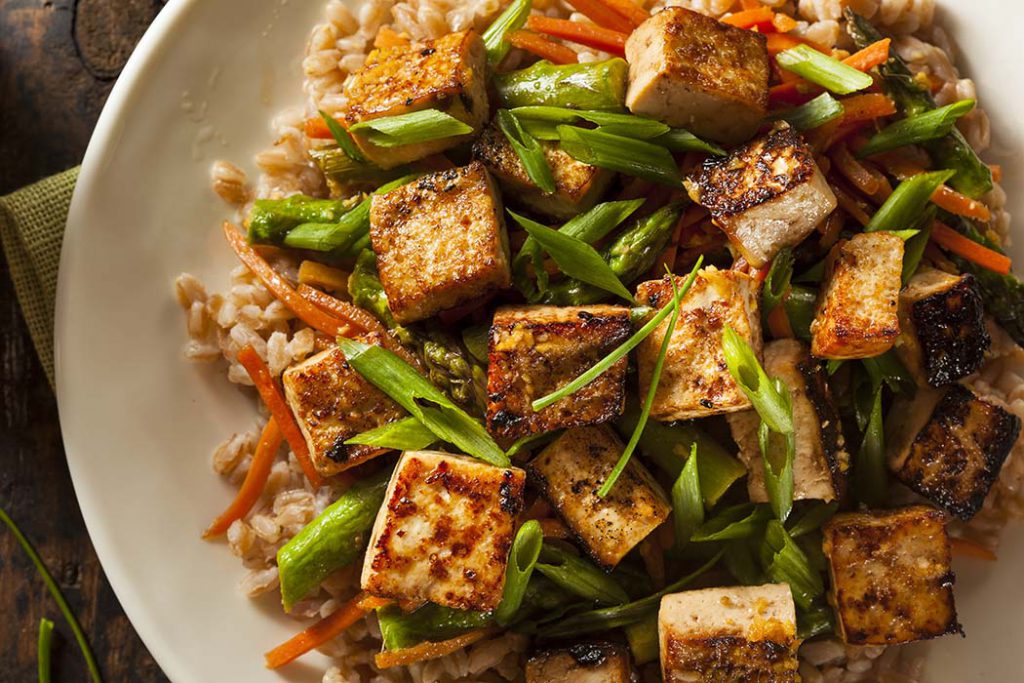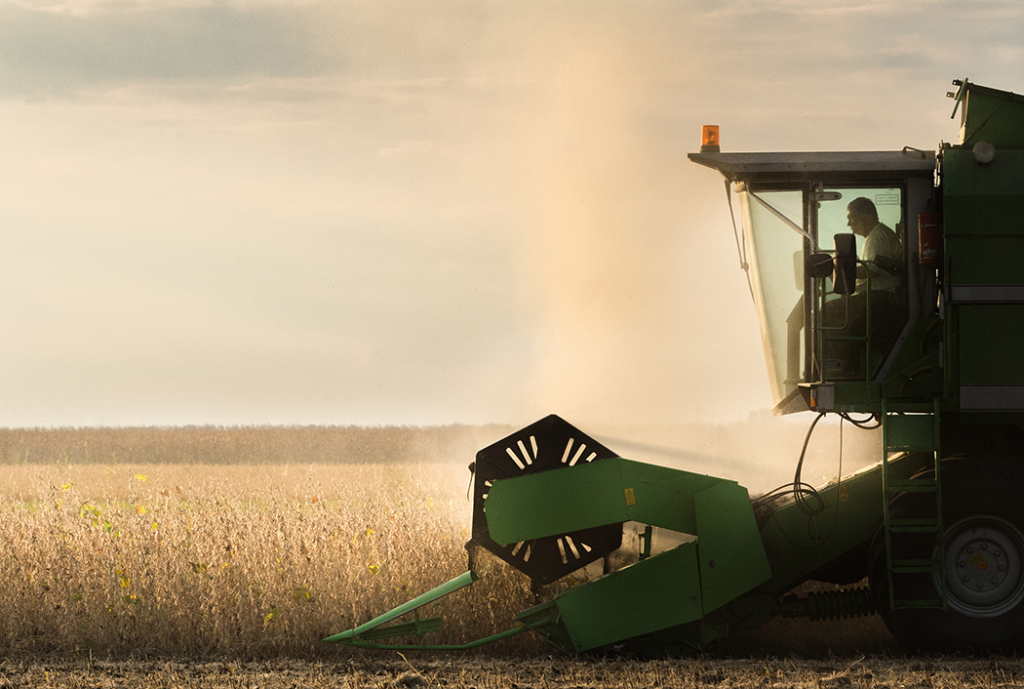The Story of Soy: Myth, Facts and Health Benefits

Written by: Michelle Jaelin, Registered Dietitian
From tofu, tempeh to other alternative protein options, most of them come from one plant: The soybean plant. As one of the most misunderstood foods, tofu, along with these other soy-based food products have risen in popularity in the past few decades due to a growing interest in vegetarianism, veganism, and plant-based eating. Here’s what you need to know about soy, Canada’s most important grain legume crop, with about 75% of soybeans produced right here in Ontario.
History
Soybeans were first discovered in Northeastern China about 2000 years ago during the Han Dynasty. It was one of the five classical grains, similar to the five grain groups of barley, corn, oat, soybean and wheat produced by Grain Farmers in Ontario. Eating mature soybeans however, was not palatable. While there are several anecdotes of how tofu came to be, Jia Chen “Wendy” Fu a Professor at Chinese Emory University describes how soy milk and tofu also known as “bean curd” were most likely created. During the Han Dynasty, northern and western neighbours consumed dairy. It is likely that seeing and absorbing the processing of dairy milk inspired them to make something similar, known unofficially as the “cheese inspiration theory.” About 1000 years later, with mostly the help of vegetarian Buddhist monks, tofu and soy milk (made from soybeans) were widely eaten in Asia, including in Japan, Korea, Taiwan, Malaysia and Indonesia, Vietnam, the Philippines, and more.
As you can imagine, soy products did not take off in the western world until centuries later. European explorers discovered it in the 1700s, describing it as “strange cheese,” and it still, wasn’t widely adopted in the west. In North America, it wasn’t until about the 1960s, during the counterculture hippie revolution where the shift towards vegetarianism became a trend. Up until that time, the only consumers of soy were people of Chinese and Japanese descent, as well as Seventh Day Adventists whose religious dietary restriction was to not eat animals. Inspired by the Civil Rights Movement and global famine, hippies adopted eating soy to contribute to saving the planet. But tofu still hadn’t gone mainstream in the west.
In the 1980s, tofu became more approachable to non-Asians in Canada also thanks to several Chinese and Japanese immigrants. Peter Joe, a Chinese-Canadian and CEO of Sunrise Soya Foods in B.C., Japanese-Canadian Koichi Watanabe, founder of Soyarie in Quebec and Ying Ying Soy Food in Ontario are credited with producing tofu and soy products for not only Asian Canadian customers, but expanding their client base to non-Asians as vegetarianism and plant based eating continued to grow.
Soy in Ontario Agriculture

In 1881, soybeans (known as Soja beans) were first cultivated by Mr. Bruce of the John A Bruce & Co., a seedsman of Hamilton, Ontario. Then in 1893, they were cultivated for a second time in Ontario, by Charles A Zavitz who obtained them from the Kansas Agricultural Experiment Station in the USA, who obtained their soybeans from Japan. Zavitz begins a lifetime of research on soybeans suited to Ontario.
By the 1920s, soybeans are cultivated commercially across the province, with the main areas of production in central and southwestern Ontario. Canada, specifically Ontario becomes Canada’s most important grain legume crop, exporting soybeans all over the world. Canada is now a world leader in soybean production, with customers in the Pacific Rim such as Japan, Malaysia and Singapore – where they are used to make delicious soy foods such as tofu, soymilk, miso, soy sauce and other traditional soy foods. The majority of all soybean production in Canada takes place Ontario.
Soy and Your Health
As a food that has taken up popularity within the last several decades, there is lots of misinformation about it. As a registered dietitian, these are the most common questions I get asked about soy and your health.
Soy and Thyroid Health
One concern about soy is its potential effects on thyroid health for those with thyroid disorders. Goitrogens are compounds in soy that can affect the function of the thyroid gland. However, human evidence suggests soy consumption does not have much of an effect on the thyroid. Ensure adequate intake of iodine (iodinized table salt) and selenium (Brazil nuts, meat, fish, sunflower seeds) to limit the effect of goitrogens in foods.
Heart Health
In 2015, Health Canada released a statement that soy proteins could reduce total cholesterol. Since then, there has been some more evidence that soy can reduce heart disease. The greatest benefit of consuming soy protein is the health benefits over consuming other protein sources, such as red meat.

Men’s Health and Testosterone
A review of several clinical studies concludes soy does not affect testosterone or estrogen levels in men. Soy foods also do not affect male fertility.
Prostate cancer is highest in western countries and lowest in Asian countries, where soy foods are part of the everyday diet. Soy is associated with a reduced risk of prostate cancer in men.
Soy and Breast Cancer
The misunderstanding that soy increases risk of breast cancer comes from the thought that isoflavones (a compound found in soy) can act like estrogen in the body, Increased estrogen has been linked to breast cancer. However, this was seen in mice studies, not human. Soy intake has been shown to have a protective effect against breast cancer.
Uses / How to Enjoy
Enjoying tofu as an alternative protein is one of the most popular ways to consume it. This recipe for a plant-based tofu stir fry is hugely popular and hunger satisfying. Try this nutritious Charred Tofu and Barley Bowl recipe for your next family dinner. You can also get creative with silken tofu by putting it in your next post-workout smoothie.
Good in Every Grain has several more delicious recipes that use tofu. Find those under Good in Every Meal on the blog.
Bottomline
Soy protein is safe, nutrition and delicious to eat. Soybean production and farming is also one of Ontario’s largest grain exports, putting Canada in the lead as one of the world’s top producers.
Michelle Jaelin is TV and digital media Nutrition Expert, licensed registered dietitian, content creator and writer at NutritionArtist.com. She resides in Hamilton, ON with her spouse and rescue dog. Follow her @nutritionartist on Instagram and Twitter.




